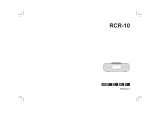
12
GB
F
E
La marque et les logos Bluetooth® sont des marques
déposées appartenant à Bluetooth SIG, Inc. et toute
utilisation de ces marques par SANGEAN ELECTRONICS
INC. est soumise à une licence.
Ces instructions concernant la réparation sont à
utiliser par du personnel qualifié uniquement. Pour
réduire le risque de choc électrique, ne procédez à
aucune réparation autre que celles détaillées dans ces
instructions d’utilisation a moins que vous ne disposiez
des qualifications.
PRÉCAUTION
T R È S I M P O R TA N T V E U I L L E Z L I R E
ATTENTIVEMENT
Sangean suggère que vous gardiez votre adaptateur
secteur au moins à 12 pouces de la radio tout en
écoutant la bande AM.
Votre Sangean Radio est alimenté par un adaptateur
secteur qui est du type « commutant » ou en « mode
commutateur ». Le DOE (Département de l’Energie) a un
mandat fédéral, exigeant que tous les fabricants utilisent
ce type d’alimentation. Cette nouvelle technologie
d’économie d’énergie a malheureusement pour effet
secondaire de causer des interférences à la bande radio
AM. Par conséquent, nous recommandons que les
utilisateurs conservent au moins une distance de 1 pied
entre l’adaptateur secteur et la radio. Cette interférence
n’affectera la Bande FM. Si vous avez des questions
veuillez contacter le service clientèle au (888)726-4326,
(562)941-9900 ou au service@sangean.com
Si un adaptateur secteur n’est pas inclus dans ce modèle
et si vous souhaitez acquérir un adaptateur secteur
séparément, veuillez-vous référer aux spécifications
de l’adaptateur secteur figurant sur la dernière page du
manuel, ou veuillez contacter Sangean pour le correct
adaptateur secteur et les spécifications adéquates.
Pour en savoir plus sur le mandat du DOE veuillez
visitez: http://www1.eere.energy. gov/buildings/
appliance_standards/product.aspx/productid/23
Veuillez noter que tous les adaptateurs CA ne sont pas
les mêmes.
L'adaptateur CA fourni avec cette radio est conçu pour
être utilisé exclusivement avec cet appareil. N'utilisez
pas un adaptateur CA de spécifications différentes que
celles de l'adaptateur CA fourni.
Si un adaptateur CA n'est PAS fourni avec votre radio,
afin de ne pas endommager l'unité et ne pas annuler
la garantie, les spécifications pour l'adaptateur CA sont
mentionnées en dernière page de ce manuel, ou bien
veuillez contacter Sangean pour obtenir le modèle et
les spécifications correctes de l'adaptateur CA. Pour les
clients aux USA et au Canada, veuillez appeler le 562-941-
9900 ou 888-726-4326. Pour toutes les autres régions,
veuillez nous contacter via contact@sangean.com.
N'utilisez pas un adaptateur CA qui ne répond pas aux
spécifications appropriées.
Pour les États-Unis:
Précautions pour l’utilisateur
Des changements ou des modifications sur ce produit
non expressément approuvés par la partie responsable
de la conformité peut annuler le droit de l’utilisateur
d’utiliser cet équipement.
Déclarations sur l'exposition RF
REMARQUE IMPORTANTE:
Pour assurer la conformité avec les exigences de
conformité aux expositions RF de la FCC, les antennes
utilisées pour cet émetteur doivent être installée pour
permettre une distance de séparation d'au moins 20cm
(8 pouces) de toutes les personnes et ne doivent pas
être placée à côté ou fonctionner conjointement avec
une autre antenne ou émetteur. Aucun changement
sur l'antenne ou sur l'appareil n'est autorisé. Tout
changement sur l’antenne ou l’appareil pourrait aboutir
à un dépassement des conditions d’exposition aux
radiofréquences par l’appareil et annuler le droit de
l’utilisateur à faire fonctionner l’appareil.
Remarque:
Cet équipement a été testé et approuvé conforme
au limites des appareils numériques de classe B,
conformément à la partie 15 des règles de la FCC.
Ces limites ont pour objectif de fournir une protection
raisonnable contre les interférences nuisibles dans une
installation résidentielle. Cet équipement génère, utilise
et rayonne de l’énergie de fréquence radio et peut
nuire aux communications radio s’il n’est pas installé et
utilisé en accord avec les instructions du mode d’emploi.
Cependant, il n’est pas garanti que des interférences
surviennent dans une installation particulière. Si
l’équipement cause des interférences nuisibles à
la réception radio ou télévision, qui peuvent être
localisées en allumant ou en éteignant l’équipement,
l’utilisateur est encouragé à corriger les interférences
en employant une ou plusieurs des mesures suivantes:
Réorienter ou déplacer l’antenne de réception.
Séparer davantage l’équipement et le récepteur.
Connecter l’équipement à une prise de courant située
sur un circuit différent de celui du récepteur.
Demandez assistance à un revendeur ou un
technicien expérimenté dans le domaine radio / TV.
Avertissements
Ne laissez pas cette radio être
exposé à l'eau, à la vapeur ou
au sable. Ne pas laisser votre
radio où la chaleur excessive
pourrait causer des dommages
comme dans une voiture garée où la chaleur du soleil
peut se renforcer, même si la température extérieure
peut ne pas sembler trop élevée.
Votre radio ne doit pas être exposé à des gouttes et à
des éclaboussures d'eau et à aucuns objets remplis de
liquides, comme des vases, qui sont placés sur la radio.
Il est recommandé d'utiliser le produit tel qu'il y a un
minimum de distance (4 pouces recommandée) à des
objets adjacents afin d'assurer une bonne ventilation.
La ventilation du produit ne doit pas être limitée en
le recouvrant ou en recouvrant ses ouvertures de
ventilation avec des objets tels que des journaux,
nappes, rideaux, etc.
Aucunes sources de flamme nue telle que des
bougies doivent être placées sur le produit.
Il est recommandé d'éviter d'utiliser ou de ranger
le produit à des températures extrêmes. Évitez de
laisser l’appareil dans les voitures, sur les rebords de
fenêtre ou directement à la lumière du soleil, etc.
CONSIGNES DE SÉCURITÉ
IMPORTANTES




















